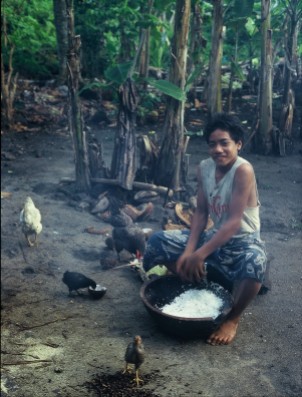Author’s note: Weekends with my aiga (extended family) on Manono Island were excellent opportunities to practice my Samoan language skills. My hosts spoke no English, but were exceedingly patient and had a wonderful sense of humor – often roaring uncontrollably with laughter at my efforts to learn the language – which I eventually succeeded in doing.

Living in Samoa brings one close to life – and death. Babies are born at home. Chickens and pigs are raised, then slaughtered and eaten. Fish is caught from the sea and other delicacies are gathered daily from the reef at low tide.
Sunday mornings, we were up well before dawn to build the umu (rock oven), scrape coconuts and squeeze the shredded coconut meat through the husk into cream. I held the torch while my brother Malie knocked a pig out with a few well-aimed rocks to the head before finishing the job with a pipe pressed across its throat.
After singeing the hair off in the fire, we scrubbed and scraped it clean. I held the carcass steady as Malie slit the belly and then thrust his hand into the warm gut to rip out its contents, including the heart and liver, which we wrapped in banana leaves for the oven.
Stuffing the cavity with dry leaves, we covered it with hot rocks along with taro (starchy root), palusami (young taro leaves filled with coconut cream and fresh vegitables), bananas, and fish wrapped neatly in woven coconut leaves and covered with large green banana leaves to bake.

Manono Island is a prime example of tropical beauty and unspoiled Polynesian culture. For the most part, people here live as they have for thousands of years, with the addition of one significant influence – the Church. Since 1830, Christianity has become a central part of Samoan culture.
Each village has at least one church. Everyone goes to lotu (worship services) each evening and twice on Sundays. Women dress up in white hats and puletasi (full-length dresses). Men wear white shirts and lava lava (a skirt-like wrap-around).
Kids sit together in church under the watchful eye of an adult parishioner wielding a long switch poised to quiet a fidgety youngster. The faife’au (pastor) reads scripture and delivers a thundering “fire and brimstone” message in the tradition of the early missionaries. In full and perfect harmony, the congregation sings hymns accompanied by a small organ. Monetary offerings are announced in church – a real “keep up with the Jones” obligation to the church.
Lotu-a-Tamaiti (White Sunday or Children’s Sunday) falls on the second Sunday in October and is as big a day as Christmas for the children of Samoa. It is the only day of the year that the children get the best food, eat first, and enjoy tasty deserts at home. To’ona’i (mid-day feast) is prepared by the adult family members and served to the children – a complete role reversal. As usual, the best and largest portions are given to the faife’au (pastor) as a meaalofa (love gift).

The children lead both Sunday services (morning and evening) singing songs and performing skits. At lunch, women offer their breasts to the babies – so, as we feast on baked pig, taro and fish, the little ones get mother’s own freshness.
A Samoan fale (house) typically has very little furniture, or anything else for that matter – except a boom box, for news and music. Mats woven from locally grown flax cover the floor for sitting, eating, and sleeping – and although I brought gifts (soap, basic medicines, etc) whenever I visited my aiga, even special items like swim goggles and a fishing knife for my father Uila might be gone the next time I visited, having already been given away to someone else.
Apparently it is more honorable to give your possessions away than to accumulate things. On the other hand, sandals left unattended or clothing drying on the line might just walk away. Whenever I ran into someone wearing one of my shirts (or my sunglasses, etc), I would be politely assured they would be returned – and even laundered. Otherwise, they were gone.

Uila told me he had 14 children, but every time I visited there were new faces, others missing from the gathering, someone else pregnant, etc. It was not uncommon for family members – young children included – to move from one extended family household to another as circumstances dictate, including unmarried daughters to the pastor’s house – presumably for safe keeping.
An interesting phenomenon in many parts of Polynesia is mo’i totolo (sleep crawling) whereby secret rendezvous are managed by sneaking under the raised floor of your sweetheart’s fale and poking a stick through the floor slats, then sneaking down to the beach together – romance in the islands!
Stay tuned for more stories, coming soon!
You can read more about Jim’s backstory, here and here.

